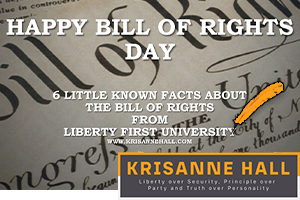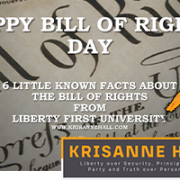6 Little Known Facts About The Bill of Rights
6 Little Known Facts About The Bill of Rights
by KrisAnne Hall, JD
Here are 6 little known facts about the Bill of Rights to help you defend Liberty.
1. The Bill of Rights is not an afterthought of the founders to “correct” the Constitution. It was actually a negotiated condition for ratifying the Constitution.
The delegates of of 5 States were refusing to ratify the Constitution, Virginia was one of those States. Virginia delegates agreed to ratify the Constitution only if there would be a guarantee of debate on provisions to add a Bill of Rights.
On 7 Mar. 1788 the Virginia Baptist General Committee discussed the Constitution:
“Whether the new Federal Constitution which had now lately made its appearance in public, made sufficient provision for the secure enjoyment of religious liberty; on which it was agreed unanimously that, in the opinion of the General Committee, it did not.”
Without Virginia’s consent there would be no Union, no Constitution, & no federal government. In order to form the Union, the other 8 States agreed to adding a Bill of Rights.
2. The Bill of Right was not established to “control” the federal government. It was written to “remind” the people to never let government control their inherent rights.
In the debate of the ratification of the Bill of Rights, the argument was made proving the intent and purpose of the Bill of Rights. Not a document to control government, but a document to remind the people. In The Letter From A Federal Farmer To The Republican #6 this truth is articulated:
“…Fortunate it is for the body of a people, if they can continue attentive to their liberties, long enough to erect for them a temple, and constitutional barriers for their permanent security: when they are well fixed between the powers of the rulers and the rights of the people, they become visible boundaries, constantly seen by all, and any transgression of them is immediately discovered: they serve as centinels for the people at all times, and especially in those unavoidable intervals of inattention.”
The Bill of Rights was permanently placed within the Constitution to be a “constant reminder” to the people to control the limited power of their government. The Constitution is not a restraint on government, as it is simply a paper with ink. Our founders said the Constitution was simply a “parchment barrier” without the “true republican jealousy and vigilance [of the people], the strongest guard against the abuses of power.”
***Therefore, the Bill of Rights did not “establish” or “grant” rigths to the people. It recognized the rights of the people that already exist!***
3. “You have the right to remain silent and everything you say can and will be used against you in a court of law. You have the right to talk to an attorney and have him present during questioning. If you cannot afford one, an attorney will be provided to you for your defense” is not from a Supreme Court case, it is a summary of a few of the principles in the 5th & 6th Amendments in the Bill of Rights.
The 5th Amendment reminds us: No person…shall be compelled in any criminal case to be a witness against himself.”
The 6th Amendment reminds us: “In all criminal prosecutions, the accused shall enjoy the right…to have the Assistance of Counsel for his defence.”
These are not rights “bestowed” by judges in a courtroom. These are rights that are essential to the protection of the inherent rights of all citizens.

4. There is only one exception to the rights of the people to be secure in their property & privacy and it is clearly outlined in the Bill of Rights.
Today’s courts have devised a laundry list of reasons why those in government and their agents can search and seize all forms of property from the people without a warrant or proper due process. These are all inventions by those in government to increase the power of those in government contrary to the explicit language of the 4th Amendment.
The 4th Amendment reads:
“The right of the people to be secure in their persons, houses, papers, and effects, against unreasonable searches and seizures, shall not be violated,”
The 4th Amendment then continues to outline the only exception to that right that “shall not be violated” and that one exception contains five elements that must be present, at the same time, for a search a seizure to respect the rights of the people. Every search and seizure must contain:
- A Warrant
- Based upon probable cause
- Sworn by a supported by Oath or affirmation
- That warrant must particularly describing the place to be searched
- And that warrant must particularly describe the persons or things to be seized
Without those five elements the search and seizure is a violation of the rights, regardless of the excuse anyone in government can imagine.
5. The 9th & 10th Amendments are the most important parts of the entire Constitution as they establish the rules for the application of every article, section, & clause of both the Constitution and the Bill of Rights.
The 9th & 10th Amendments look different from all the other Amendments in the Bill of Rights and that is because they serve a different purpose. They are not reminders of rights like the first eight, they are recitations of powers.
In legal terms they are referred to as “rules of construction.” The 9th and 10th Amendments provide the rules for the application of every term and delegation of power in the Constitution & Bill of Rights. Rule #1 is the 9th Amendment which tells us that all the Rights in the universe belong to the people. It doesn’t matter if they are enumerated or not; all the right belong to the people. Rule #2 is the 10th Amendment that tells us all the powers of government belong to the State and the People unless they are specifically listed in the Constitution. That means if the power is not specifically delegated to the federal government, then it is specifically reserved to the States and the people. Rule #2 does not allow “plenary powers” or “interpreted powers” to exist in the federal government. If it is not in writing, it does not exist at the federal level.
6. The “Supremacy Clause” does not make all federal laws and regulations supreme to the States or the people. Watch & Share this short video on YouTube
Article 6 clause 2 is what we refer to as the Supremacy Clause. The Supremacy Clause is titled so because it declares the Constitution to be the “supreme law of the land.” It does NOT make all federal laws, federal regulations, or Supreme Court opinions supreme laws of the land. The Supremacy Clause very clearly declares that only laws made by Congress that are made pursuant to the limited terms of the Constitution are supreme over State laws. If Congress makes a law, if the executive makes a regulation, if the Supreme Court issues an opinion an these acts are not made consistent with the limited enumerations of the Constitution, the Supremacy Clause actually declares these acts to be not binding on the States, they are legally “null and void.” And the drafters of the Constitution, made this principle more than clear in their statements:
“No legislative act, therefore, contrary to the Constitution, can be valid.” Federalist #78
“…the power of the Constitution predominates. Any thing, therefore, that shall be enacted by Congress contrary thereto, will not have the force of law. ~ James Wilson, Madison’s Notes on the Convention
I will propose to you, that if these were widely known facts about the Bill of Rights, rather than little known facts, America would be a very different place today. Kindle the spirit of Liberty with this education and watch as it spreads to ignite, unite, and activate Americans to Make America Liberty Again!
Learn more about these facts at www.LibertyFirstSociety.com.


